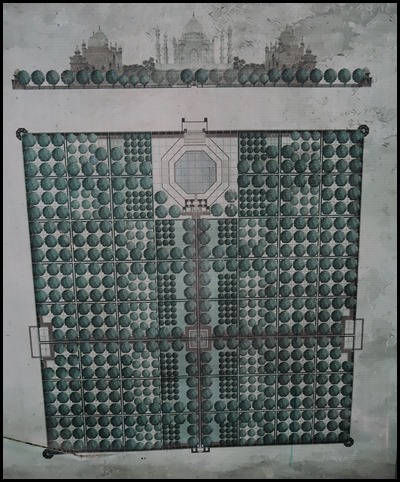The Mahtab-Bagh

Beez Neez now Chy Whella
Big Bear and Pepe Millard
Mon 15 Apr 2019 23:47
|
The Mahtab-Bagh (The Moon Garden) to Enjoy a Taj
Sunset    The twenty minute ride from our digs
to the Moon Garden was filled with commuter traffic, heavily
laden bikes, a waiting camel and finally Mob (our driver) buying our entrance tickets. He went back
to the car to wait and we bimbled on.
 The sign on the
gate.
 A very busy stone
carved information tablet reads:
Babur (reign 1526 – 30 AD) came
to Agra soon after the Battle of Panipat (20th April 1526), here he was much
tortured by heat, hot winds and dust. He was also complained, in his memoirs, of
the lack if running water (through canals and cascades) and gardens with which
he was accustomed and had seen a large number of them at Samarqand, such as
Bagh-I-Dilkusha, Bagh-I-Chenar and Hagh-I-Bihisht, he had founded several
gardens at Kabul: Bagh-I-Vafa, Bagh-I-Kalan, Bagh-I-Banafsha, Bagh-I-Padshahi
and Bagh-I-Chenar. It was in this tradition that he founded gardens on the left
(eastern) bank of the River Jamuna (Yamuna) at Agra, e.g. Bagh-I-Gul Afshan (The
Flower-Scattering Garden) (present Ram-Bagh); Bagh-I-Zar-Afshan (The Gold
Scattering Garden) (present Chauburj); and Bagh-I-Hasht (The Garden of
Eight Paradises), as he has recorded in his memoirs. He noted that his nobles
also founded garden here, so much so that “the people of Hind who had never seen
grounds planned so symmetrically and thus laid out, called the side of the Jun
(River Jamuna) where (our) residences were, Kabul.” His record shows that his
Bagh-I-Hasht Bihist was situated just in front of the Agra Fort, most probably,
at or near this place, enabling him to cross the river and reach here swiftly
and frequently. The Mughals were certainly occupying this area and, to cater to
their religious needs, Humayun (reign 1530-40, 1555) built a large mosque in
this locality. This mosque survived and bears the inscription dated in A.H. 937
/ 1530 A.D.. His astronomical observatory, now in ruins and known as
‘Gyarah-Siddi’, is also situated in its vicinity. The area has large scale ruins
of Mughal gardens. Later, Akbar (1556 – 1605) seems to have granted this place
on both sides of the river, in Jagir, to Rajaman Singh Kachhwaha of Amer.
whereby the village came to be known as ‘Kachhpura’.
A plan of the garden with the Taj Mahal at the top (across the river) and an 18th century plan (with the garden at the top). Shah Jehan (1628 – 1658 A.D.),
Akbar’s grandson, procured this site (on both banks of the river) building a
magnificent tomb in the memory of his deceased Queen Mumtaz Mahal, from Man
Singh’s grandson Mirza Raja Jai Singh, in lieu of four ‘Havelis’, as is on
record, the grand mausoleum, viz, the Taj Mahal, with subsidiary buildings,
chowk (court), dalans, gateway and spacious garden was laid out, on three
receding levels, on the right bank, the stupendous main tomb of white marble
standing imposingly on the edge of the river. He also built this spacious
garden, viz, the Mahtab-Bagh on the tradition of garden-craft founded Babur, on
this side of the river, facing the Taj Mahal, just to provide a beautiful
backdrop to the main tomb. It was ingeniously planned on one plan level. First,
a large octagonal tank of brick masonry, each internal side of which measured
36.70 metres (appro. 80 feet), was built. Each side had 16 scalloped arches, to
make up a beautiful border of the tank. On its south, west, north and east sides
were spacious bunglas (pavilions with curved chhajjas and roofs) which were
interconnected by wide dalans (cusped) arches. corridors, on other sides. All
these were built of red sandstone, and engrailed (cusped) arches, pillars,
carved panels and other architectural parts of this vast structure, in typical
Shahjehanian style have survived in the ruins. There were 25 fountains in the
tank. These were inlets of water which was supplied by overhead tanks through
water-tight terracotta pipes, which have all disappeared. On its northern side
is an oblong red stone tank, with scalloped corners. Water from the main
octagonal tank flowed, through a slit under the northern bungla,and fell into
this oblong tank in the form of a water-fall (abshar), behind which a
chini-khanah (series of niches for candles in the night, and flower guldastas in
the day) is provided. A large char-bagh (four-quartered garden) was laid out on
its northern side. It was divided into four quarters with a square lotus-tank in
the centre. It also has scalloped corners. Shallow stone canals, with
stone-paved pathways on both sides, now extinct, were built from this central
tank to the middle of the four sides. Water flowed from the main tank to the
oblong tank and thence to the canals of this garden. There were barahdaris (ope,
arched pavilions) on the western, northern and eastern sides of the char-bagh.
These too have been destroyed, The enclosing wall has also disappeared and only
its river-side, south-eastern tower has remained. Aurangzeb, in his letter dated
8 Muharram 1063 Hijri (= 9 December 1652 A.D.), mentioned Mahtab-Bagh and noted
that it was recently submerged under flood water. But the octagonal tank and
bunglas had remained unaffected. In the
later ages, the buildings collapsed and the garden was covered by sand deposited
by river floods, and it was forgotten. The Archaeological Survey of India, has
excavated it and it is now being restored and conserved. Nearly 8000 trees and
plants from the Mughal repertoire have been planted by the
A.S.I.
The Mahtab-Bagh laid out in perfect symmetry
and alignment with the Taj Mahal, and there is absolutely no doubt that it was
planned and built as an integral part of the original design of the Taj Mahal,
during the period from 1631 to 1635 A.D. it seems to have been named the
‘Mahtab-Bagh’ (the Moon Garden) because it is an ideal place for viewing the Taj
Mahal in moonlight.
  We bimbled along the path – trees in
neat lines to the right and to the left.
  Newly watered, puddles made for good
baths for the birds. Oooo there was the Taj Mahal.
 At the end of the track we saw the
ruins of the various garden
buildings.........
 ...........we settled in front of the
scalloped water feature.
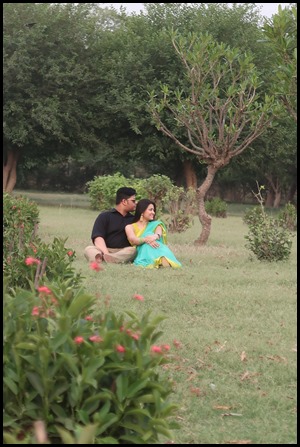   A photo shoot
to our left. Bear and I pose with
the Taj.
 Taking in the neat
lines of trees.
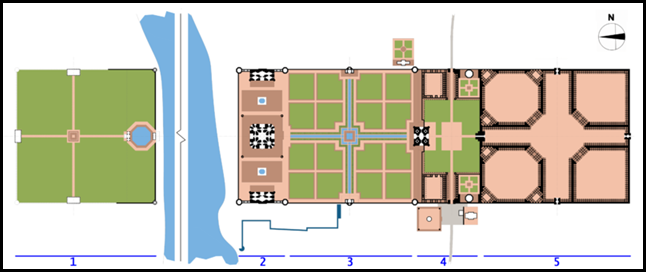 This plan was drawn by McGinnly.
It shows the lines of this garden (far left) were in perfect line with the Taj
gardens.
 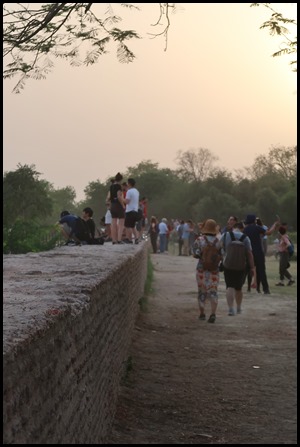  I passed a little
cutie as I checked out the wall by the river.
As sunset approached birds went home to
roost.
  Just before
sunset and ten minutes after.
 We did get our post sunset pink glow – just.
  A nice security guard asked if we
would like our pictures taken, we enthusiastically
nodded. He took a few and then asked for “money as a tip for pictures”.
Oh, I don’t carry and Bear had left the purse in the
car.....Ooops......
 Our final views
(ever) of the Taj Mahal as we left the garden. Roosting birds making a
real song about it.
 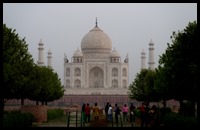  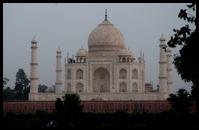 ALL IN ALL LOVED THE GARDEN,
LOVED THE VIEW, LOVE THE HISTORY
A NICE VIEW OF THE TAJ MAHAL BUT NOT THE BEST
SUNSET |
